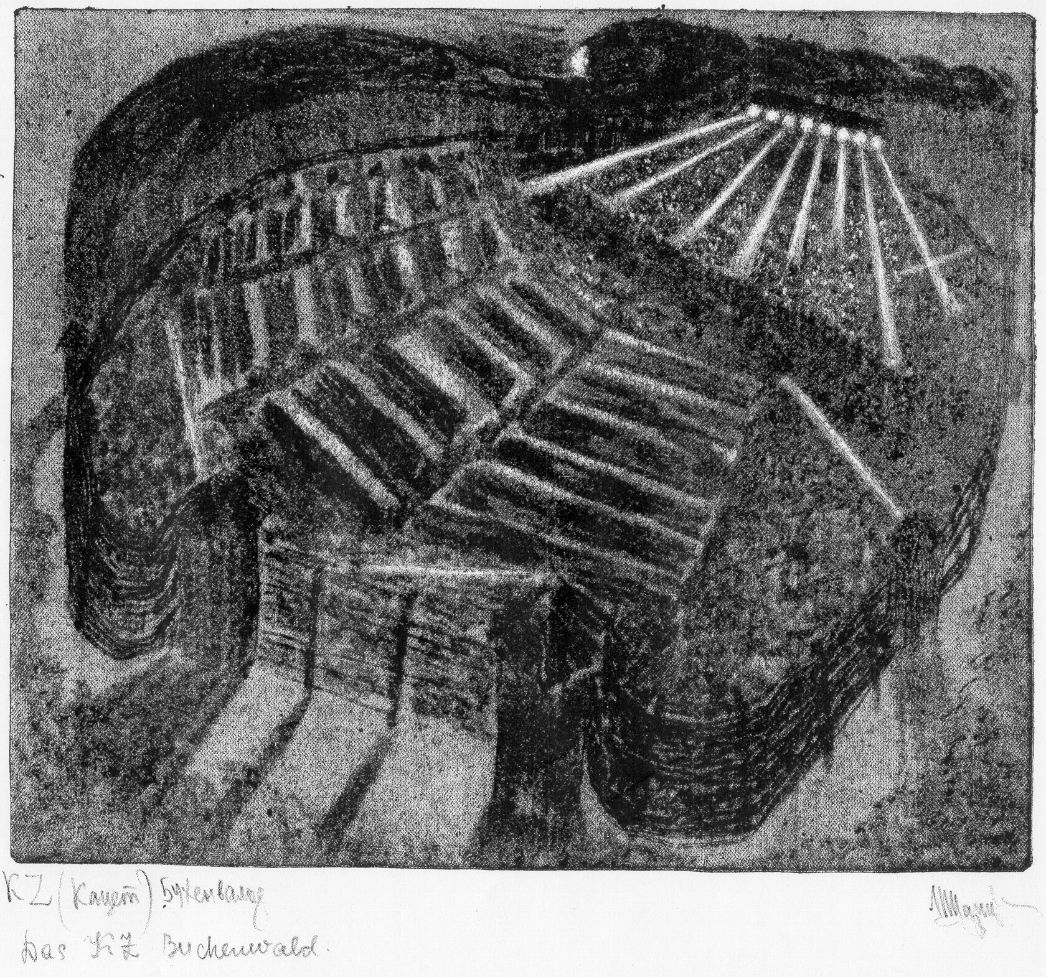
The etching “KZ (Kacet) Buchenwald” by Leonid Caricynski is one of the few instances of an artistic processing of the fate of Soviet prisoners of war and forced labourers in the collection of the Buchenwald and Mittelbau-Dora Memorials Foundation. It is one of the most powerful of the twenty works of printmaking by Caricynski in the art collection. It depicts the camp grounds surrounded by a barbed-wire wall, with the inmates’ barracks built into the northern slope of the Ettersberg in terrace fashion. Spotlights shine across the muster ground to illuminate the individual barrack zones to the very depths of the slope. It is as if the light penetrates the entire space, symbolizing the presence of terror in every last nook and cranny. Adopting specific details of the camp architecture, Caricynski here visualized the inescapable horror to which the inmates were subjected in a kind of metaphorical condensation.
For a long time, the topic of the Soviet inmates in the concentration camp was as much a taboo in art as it was in the entire public life of the Soviet Union. After the period of imposed silence in the post-war years, Caricynski began communicating the deadly threats of the war days and processing them in the drawing medium. It was then that he arrived at metaphorical representation as a form of expression for his extreme existential experiences.
Biography
Leonid Ivanovič Caricynski was born in Solomenskoe in southern Russia on 11 August 1920 and grew up primarily in Chechnya. He was conscripted for service in the Red Army in 1940 and trained as a “politruk” (“political commissar”). At the time of the German invasion of the Soviet Union, his unit was stationed on the western border of the country in Galicia, where it was crushed by the Wehrmacht. What followed for Caricynski were weeks of a desperate attempt to stay out of the hands of the Germans. He succeeded in creating a new identity for himself under the name “Aleksandr Salnik”. In April 1942, however, he was deported to Germany to perform forced labour. There he was arrested for engaging in resistance activities and, on 27 January 1944, committed to the Buchenwald concentration camp as a “political Russian” with the number 37936. At Buchenwald he was involved in the secret activities of the Russian resistance.
After his liberation from the Buchenwald concentration camp on 11 April 1945, Leonid Caricynski—like many former Soviet inmates—fell into the clutches of the Soviet secret service NKVD in the Soviet Union. He was able to free himself with the help of some of his companions from the camp resistance. He taught drawing and painting and studied art himself; in 1957/63 he attended the “Ilya Yefimovich Repin” Institute of Painting, Sculpture and Architecture in Leningrad (present-day St. Petersburg). In several printmaking cycles he revisited his experiences in the Red Army, as a forced labourer in the German wartime economy, and as a political inmate in the Buchenwald concentration camp. Participation in numerous exhibitions in the Soviet Union and abroad (including the graphic arts biennial in Florence in 1972) followed. In 1968 he was accorded the special honour of admission to the Artists’ Union of the USSR (Soyuz Khudozhnikov). From 1969 onwards, Leonid Caricynski lived in Grosny. He died in Moscow, presumably of injuries sustained in an automobile accident. (The date of death is not known.)
*About two days after the liberation of the Buchenwald concentration camp in April 1945, in: Valentin Logunov: “V podpolʹe Bukhenvalʹda” (In the Resistance in Buchenwald), 1963


